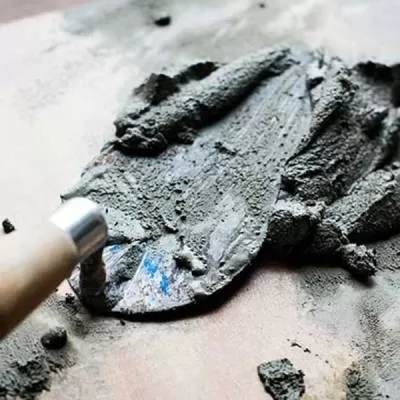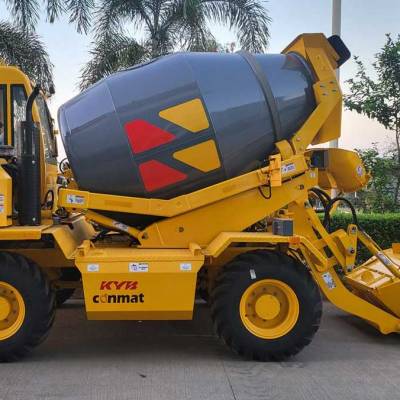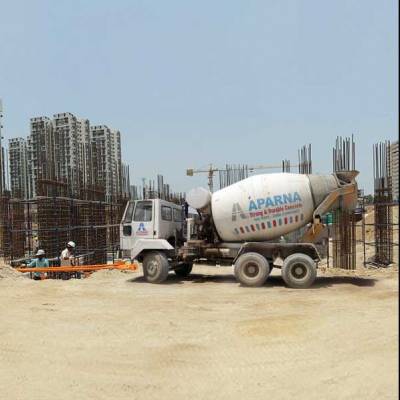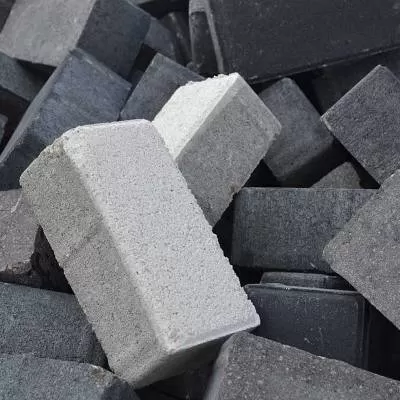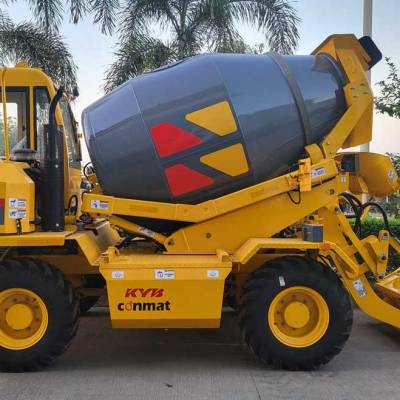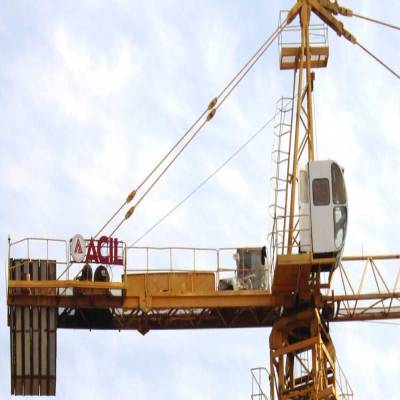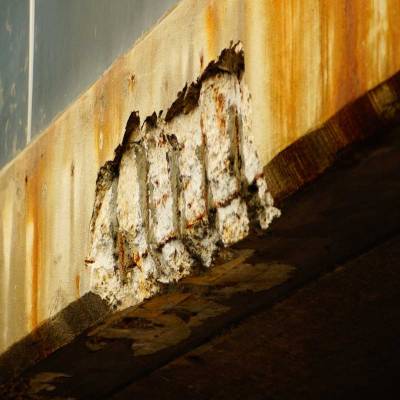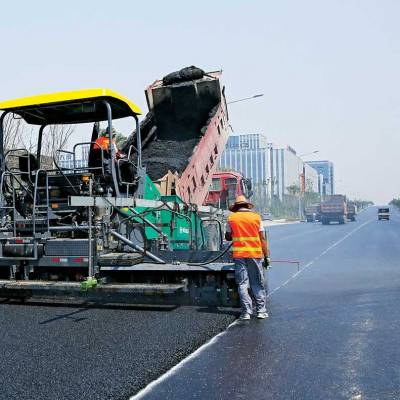- Home
- Building Material
- Concrete
- Ready to mix?
Ready to mix?
The advantages of ready-mix concrete (RMC) are now evident: consistent quality, faster construction with lesser manpower and good housekeeping at sites. However, despite India being the second largest producer of cement, the penetration of RMC is abysmal. While the commercial RMC market is about 30 million cu m per year, project-based captive consumption of RMC is estimated to be in excess of 35 million cu m. These captive plants are mainly put up by contractors for internal consumption. Hence, the market penetration of commercial RMC works out to slightly over 10 per cent. However, the market penetration in cities where commercial RMC has existed in excess of 10 years is in the range of 25 per cent to 35 per cent. This is still relatively low compared to advanced countries like the US, Europe and Japan.
Industry take
In India, the RMC industry is still in its growth phase, agrees Rashid R Merchant, Associate Vice President (Development and Marketing), RMC Readymix (India) (a division of Prism Cement). "The industry will continue to grow in the near future, with large-scale demand coming from infrastructure and housing projects, which are likely to come up in the Twelfth Five-Year Plan," he says. "Even in developed countries like the US and Europe, it took many years for the concept to catch up."
The current RMC equipment market stands at about $300 million, roughly about Rs 1,500 crore. "Up to 2008, the industry was growing at a CAGR of 65 per cent," says Anand Sundaresan, Managing Director, Schwing Stetter India. "But there was a sudden dip during the 2009 downturn." And while the first six months of 2011 were smooth with the business growing by more than 30-35 per cent, again, after July 2011, the market dropped. And even in this calendar year, the market is flat.
Well-equipped
To produce concrete, you need a batching plant; to transfer it, you require a truck mixer; and to further place it, you choose a truck-mounted pump, spraying equipment, conveyor-attached truck mixer, etc. All RMC equipment is available in India. As Sundaresan tells us, the batching plant - from 20 cu m capacity going up to 270 cu m - is the starting point. In the case of truck mixers, Indian contractors predominantly use the 6 cu m mixer, though smaller capacity mixers (say, 4 cu m) are used in certain projects like canals. "As concrete trucks cannot be brought in during the day and RMC companies have a window only at night to concrete in cities like Mumbai, Delhi and Chennai, we introduced a 3-cu-m mixer called Nimo," he adds. And with companies like Mercedes, Tata and Ashok Leyland in the market the demand for higher capacity trucks of 7-10 cu m is increasing.
Further, the concrete pump - most commonly used û is stored with the help of a tractor, but has its own limitations like manual handling. Hence, customers have started opting for the truck-mounted pump because the logistics and the pumping movement become easier. As Sundaresan says, "The current trend is the truck-mounted boom pump, available in various capacities and boom sizes like 17 m, 20 m, 36 m, etc." Last, the truck conveyor belt makes it convenient to pour concrete in the case of a huge foundation. Also, for tunnel concreting, concrete is sprayed inside the tunnel; this can be done with shotcreting equipment. "Schwing Stetter provides equipment where the company can bring back the residual concrete in the concrete mixer and recycle it, segregate the aggregate and reuse the flurry for producing concrete," adds Sundaresan. "This is both environment-friendly and cost-effective."
Not all users prefer an RMC plant of their own. "In most cases, we buy RMC," says Pinaki Bosu, General Manager & Head-Purchase, Peninsula Land. However, for large projects, it is desirable, as he tells us. "There is a JW Marriot coming up next to the international airport over 50 lakh sq ft. Hence, it makes sense to go with a plant of your own as it assures supply."
Calling RMC "the need of the day" for high rises, Bosu says, "In China, they are putting up 150 or 200-room hotels in just 15 days. Everything is done in the factory, then brought to the site and assembled." For his part, Sundaresan adds, "For high-rise buildings of 300-500 m, you need a high-pressure concrete pump. And in cities like Mumbai, where it is hard to lay a pipeline and pour concrete for 60-storey buildings, you can consider a separate placing boom for concreting."
Overcoming challenges
The most immediate challenge, of course, is to increase the use of RMC. While he accepts that RMC is beneficial for road construction, a senior official from Bihar Urban Infrastructure Corporation says, "The problem is lack of good transit facility and traffic movement. Working in the city is most difficult. As casting and much infrastructure work have to be done at night, private parties are reluctant. Hence, RMC is not so popular."
Cost is another obstacle. "Excise duty on RMC and VAT add to an increase in the product price, which makes people reluctant," says Bosu. "However, even if the cost is 5-10 per cent higher, I would opt for RMC because it gives faster yield and turnaround." Merchant asserts, "A simple comparison of cost with site-mixed cement (SMC) makes RMC look expensive. But if you consider the benefits, it is more viable." And Sunderasan adds to it, "If you calculate the tangibles and intangibles, using RMC is cheaper than producing concrete on site."
Further, a common problem faced by RMC companies and equipment players is lack of skilled operators and labourers. Today, there are about 20,000 truck mixers in India; hence, you need about 40,000 people to operate them, and 80,000 if you take two shifts. "We are working closely with RMC companies to train people," says Sundaresan. "Apart from the batching plants, you also need skilled workers. It is not just the batching plants, but also the pumps, the truck mixers and using different accessories along with concreting for which skilled workers are required."
Centres of growth
In terms of volume, Mumbai, Bengaluru, and NCR are looked at as the top three regions for the RMC business. "The Northeast, Gujarat and Andhra Pradesh are the states where the concept is catching up," says Merchant. "Also, Tier II and III cities are becoming an important market." In terms of project construction and equipment requirement, Sundaresan believes commercial RMC has been limited to the first and second-level cities and is only now slowly entering third-level cities. "The maximum equipment, especially for road projects, is being used in the East and Northeast," he adds. "In the case of airports, it is there in Hyderabad, Bengaluru, Delhi, Mumbai, Chennai and the 30-odd Greenfield projects identified."
As for equipment and batching systems, Merchant tells us, "Sturdy and robust indigenised plants are now available and the costs are not prohibitive. The entry barrier for the industry is no longer high." Small capacity plants (30 cu m per hour and below) have mushroomed in Tier II and III cities.
Looking ahead, Merchant is optimistic, predicting that things may improve from the last quarter of 2013 if the economy picks up. Meanwhile, Sundaresan believes the government needs to drive growth by introducing more projects. "Once this happens, RMC will have a very bright future in India," he affirms. We agree.
Types of RMC
- High-strength concrete for large structures;
- Flow able concrete, which requires less labour and effort for placement;
- Concrete incorporating polypropylene and steel fibres for ground slabs, eliminating the need for reinforcing steel;
- Lightweight concrete for thermal insulation, acoustics, fillers, etc;
- Concrete in an array of colours for aesthetics;
- High-density concrete for special applications such as radiation shielding in hospitals, reactors, etc, and to add dead weight to structures;
- Concrete at lower temperatures for mass concrete pours;
- Concrete designed to capture water runoffs and for rainwater harvesting.
The market for RMC and equipment is poised for a bright future given a more proactive approach from government, discovers SHRIYAL SETHUMADHAVAN. The advantages of ready-mix concrete (RMC) are now evident: consistent quality, faster construction with lesser manpower and good housekeeping at sites. However, despite India being the second largest producer of cement, the penetration of RMC is abysmal. While the commercial RMC market is about 30 million cu m per year, project-based captive consumption of RMC is estimated to be in excess of 35 million cu m. These captive plants are mainly put up by contractors for internal consumption. Hence, the market penetration of commercial RMC works out to slightly over 10 per cent. However, the market penetration in cities where commercial RMC has existed in excess of 10 years is in the range of 25 per cent to 35 per cent. This is still relatively low compared to advanced countries like the US, Europe and Japan. Industry take In India, the RMC industry is still in its growth phase, agrees Rashid R Merchant, Associate Vice President (Development and Marketing), RMC Readymix (India) (a division of Prism Cement). "The industry will continue to grow in the near future, with large-scale demand coming from infrastructure and housing projects, which are likely to come up in the Twelfth Five-Year Plan," he says. "Even in developed countries like the US and Europe, it took many years for the concept to catch up." The current RMC equipment market stands at about $300 million, roughly about Rs 1,500 crore. "Up to 2008, the industry was growing at a CAGR of 65 per cent," says Anand Sundaresan, Managing Director, Schwing Stetter India. "But there was a sudden dip during the 2009 downturn." And while the first six months of 2011 were smooth with the business growing by more than 30-35 per cent, again, after July 2011, the market dropped. And even in this calendar year, the market is flat. Well-equipped To produce concrete, you need a batching plant; to transfer it, you require a truck mixer; and to further place it, you choose a truck-mounted pump, spraying equipment, conveyor-attached truck mixer, etc. All RMC equipment is available in India. As Sundaresan tells us, the batching plant - from 20 cu m capacity going up to 270 cu m - is the starting point. In the case of truck mixers, Indian contractors predominantly use the 6 cu m mixer, though smaller capacity mixers (say, 4 cu m) are used in certain projects like canals. "As concrete trucks cannot be brought in during the day and RMC companies have a window only at night to concrete in cities like Mumbai, Delhi and Chennai, we introduced a 3-cu-m mixer called Nimo," he adds. And with companies like Mercedes, Tata and Ashok Leyland in the market the demand for higher capacity trucks of 7-10 cu m is increasing. Further, the concrete pump - most commonly used û is stored with the help of a tractor, but has its own limitations like manual handling. Hence, customers have started opting for the truck-mounted pump because the logistics and the pumping movement become easier. As Sundaresan says, "The current trend is the truck-mounted boom pump, available in various capacities and boom sizes like 17 m, 20 m, 36 m, etc." Last, the truck conveyor belt makes it convenient to pour concrete in the case of a huge foundation. Also, for tunnel concreting, concrete is sprayed inside the tunnel; this can be done with shotcreting equipment. "Schwing Stetter provides equipment where the company can bring back the residual concrete in the concrete mixer and recycle it, segregate the aggregate and reuse the flurry for producing concrete," adds Sundaresan. "This is both environment-friendly and cost-effective." Not all users prefer an RMC plant of their own. "In most cases, we buy RMC," says Pinaki Bosu, General Manager & Head-Purchase, Peninsula Land. However, for large projects, it is desirable, as he tells us. "There is a JW Marriot coming up next to the international airport over 50 lakh sq ft. Hence, it makes sense to go with a plant of your own as it assures supply." Calling RMC "the need of the day" for high rises, Bosu says, "In China, they are putting up 150 or 200-room hotels in just 15 days. Everything is done in the factory, then brought to the site and assembled." For his part, Sundaresan adds, "For high-rise buildings of 300-500 m, you need a high-pressure concrete pump. And in cities like Mumbai, where it is hard to lay a pipeline and pour concrete for 60-storey buildings, you can consider a separate placing boom for concreting." Overcoming challenges The most immediate challenge, of course, is to increase the use of RMC. While he accepts that RMC is beneficial for road construction, a senior official from Bihar Urban Infrastructure Corporation says, "The problem is lack of good transit facility and traffic movement. Working in the city is most difficult. As casting and much infrastructure work have to be done at night, private parties are reluctant. Hence, RMC is not so popular." Cost is another obstacle. "Excise duty on RMC and VAT add to an increase in the product price, which makes people reluctant," says Bosu. "However, even if the cost is 5-10 per cent higher, I would opt for RMC because it gives faster yield and turnaround." Merchant asserts, "A simple comparison of cost with site-mixed cement (SMC) makes RMC look expensive. But if you consider the benefits, it is more viable." And Sunderasan adds to it, "If you calculate the tangibles and intangibles, using RMC is cheaper than producing concrete on site." Further, a common problem faced by RMC companies and equipment players is lack of skilled operators and labourers. Today, there are about 20,000 truck mixers in India; hence, you need about 40,000 people to operate them, and 80,000 if you take two shifts. "We are working closely with RMC companies to train people," says Sundaresan. "Apart from the batching plants, you also need skilled workers. It is not just the batching plants, but also the pumps, the truck mixers and using different accessories along with concreting for which skilled workers are required." Centres of growth In terms of volume, Mumbai, Bengaluru, and NCR are looked at as the top three regions for the RMC business. "The Northeast, Gujarat and Andhra Pradesh are the states where the concept is catching up," says Merchant. "Also, Tier II and III cities are becoming an important market." In terms of project construction and equipment requirement, Sundaresan believes commercial RMC has been limited to the first and second-level cities and is only now slowly entering third-level cities. "The maximum equipment, especially for road projects, is being used in the East and Northeast," he adds. "In the case of airports, it is there in Hyderabad, Bengaluru, Delhi, Mumbai, Chennai and the 30-odd Greenfield projects identified." As for equipment and batching systems, Merchant tells us, "Sturdy and robust indigenised plants are now available and the costs are not prohibitive. The entry barrier for the industry is no longer high." Small capacity plants (30 cu m per hour and below) have mushroomed in Tier II and III cities. Looking ahead, Merchant is optimistic, predicting that things may improve from the last quarter of 2013 if the economy picks up. Meanwhile, Sundaresan believes the government needs to drive growth by introducing more projects. "Once this happens, RMC will have a very bright future in India," he affirms. We agree. Types of RMC High-strength concrete for large structures; Flow able concrete, which requires less labour and effort for placement; Concrete incorporating polypropylene and steel fibres for ground slabs, eliminating the need for reinforcing steel; Lightweight concrete for thermal insulation, acoustics, fillers, etc; Concrete in an array of colours for aesthetics; High-density concrete for special applications such as radiation shielding in hospitals, reactors, etc, and to add dead weight to structures; Concrete at lower temperatures for mass concrete pours; Concrete designed to capture water runoffs and for rainwater harvesting.


